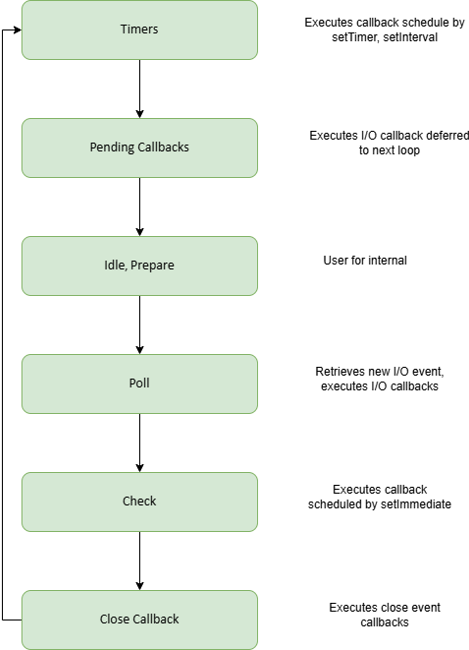Understanding the Event Loop Mechanism in Node.js: A Single-Threaded Model with Examples
NODEJS
5/29/20244 min read
Event Loop Mechanism in Node.js
The event loop is a fundamental concept in Node.js that enables non-blocking, asynchronous operations. It allows Node.js to handle multiple concurrent requests efficiently without creating multiple threads, which is different from traditional multithreaded environments.
Working of Event Loop
Initialization: When Node.js starts, it initializes the event loop.
Incoming Requests: Asynchronous operations like I/O operations, network requests, timers, etc., are initiated.
Phases of the Event Loop:
Timers: Executes callbacks scheduled by setTimeout() and setInterval().
Pending Callbacks: Executes I/O callbacks deferred to the next loop iteration.
Idle, Prepare: Internal use.
Poll: Retrieves new I/O events; executes I/O-related callbacks (almost all I/O callbacks except for those close callbacks, the ones scheduled by timers, and setImmediate()).
Check: Executes callbacks scheduled by setImmediate().
Close Callbacks: Executes close event callbacks, such as socket.on('close', ...).
Callback Execution: When an asynchronous operation completes, its callback function is added to the appropriate phase of the event loop. Node.js processes these callbacks based on their associated phase, ensuring non-blocking execution.
Here's a diagram of the Node.js event loop, illustrating its various phases and how it processes asynchronous operations:


Timers: Executes callbacks scheduled by setTimeout and setInterval.
Pending Callbacks: Executes I/O callbacks deferred to the next loop iteration.
Idle, Prepare: Internal use.
Poll: Retrieves new I/O events and executes I/O-related callbacks (except for those scheduled by timers and setImmediate).
Check: Executes callbacks scheduled by setImmediate.
Close Callbacks: Executes close event callbacks, such as when a socket or handle is closed.
The arrows indicate the flow from one phase to the next, illustrating the cyclical nature of the event loop. This loop allows Node.js to handle asynchronous operations efficiently, ensuring that the server remains responsive and can manage multiple concurrent connections.
Serving Concurrent Requests
Node.js can handle thousands of concurrent requests using the event loop because it does not create a new thread for each request. Instead, it handles I/O operations asynchronously and manages multiple operations efficiently through the event loop.
Here's an example to illustrate how Node.js serves concurrent requests using the event loop:
const http = require('http');
const server = http.createServer((req, res) => {
if (req.url === '/execute') { // Simulate a heavy computation task
setTimeout(() => {
res.writeHead(200, { 'Content-Type': 'text/plain' });
res.end('Computation complete\n'); }, 5000); // Simulates a delay
} else {
res.writeHead(200, { 'Content-Type': 'text/plain' });
res.end('Hello World\n'); } });
server.listen(3000, () => {
console.log('Server running at http://127.0.0.1:3000/');
});
In this example:
When a request is made to the /executeendpoint, a setTimeout function simulates a long-running task. This task is handled asynchronously, meaning the server can continue processing other incoming requests.
If a request is made to any other endpoint, it responds immediately.
Callback Queue and Message Queue
In the context of the Node.js event loop, two important concepts are the callback queue and the message queue. Both play crucial roles in how asynchronous operations are handled and how callbacks are executed.
Callback Queue
The callback queue, often referred to as the callback or task queue, is a data structure where the callback functions are stored when an asynchronous operation completes. These callbacks are waiting to be executed by the event loop.
How it Works:
Asynchronous Operation: When an asynchronous operation (like I/O, network request, or timer) completes, its associated callback function is placed in the callback queue.
Event Loop: The event loop continually checks the callback queue. When the call stack is empty, the event loop dequeues a callback function from the callback queue and pushes it onto the call stack for execution.
Message Queue
The message queue, often used interchangeably with the callback queue, is a broader concept that encompasses different types of tasks or messages, not just callback functions. It can include:
Timer Callbacks: Messages for setTimeout and setInterval.
I/O Callbacks: Messages for I/O operations.
Immediate Callbacks: Messages for setImmediate.
Close Callbacks: Messages for close events of resources like sockets.
How it Works:
Event Sources: Various event sources (timers, I/O operations, setImmediate, etc.) generate messages when events occur.
Queue Management: These messages are queued in the message queue, awaiting processing by the event loop.
Event Loop Phases: During each phase of the event loop, messages from the message queue that are relevant to the current phase are processed and their associated callbacks are executed.
Here's an example to illustrate how callback and message queues work in Node.js:
const fs = require('fs');
console.log('Start');
setTimeout(() => { console.log('Timeout'); }, 0);
fs.readFile(__filename, () => {
console.log('File Read'); });
setImmediate(() => { console.log('Immediate'); });
console.log('End');
Execution Flow:
Start and End are logged immediately as they are synchronous.
setTimeout places its callback in the callback queue to be executed in the Timers phase.
fs.readFile places its callback in the callback queue to be executed in the Poll phase after the file is read.
setImmediate places its callback in the callback queue to be executed in the Check phase.
When the event loop runs:
The Timers phase processes the setTimeout callback.
The Poll phase processes the fs.readFile callback once the file read operation completes.
The Check phase processes the setImmediate callback.
Summary:
Callback Queue: Specifically holds callback functions from completed asynchronous operations, waiting to be executed by the event loop.
Message Queue: A more general structure that includes various types of tasks/messages from different sources (timers, I/O, etc.), which are processed by the event loop during their respective phases.
Understanding these concepts helps in grasping how Node.js efficiently handles asynchronous operations and concurrency with a single-threaded event loop.
Benefits:
Efficiency: Handles multiple requests with a single thread, reducing overhead.
Scalability: Easily scales to handle many concurrent connections.
Non-blocking: Operations that might take a long time (like I/O operations) do not block the execution of other code.
The event loop, with its ability to handle asynchronous operations efficiently, is key to Node.js's ability to serve a high number of concurrent requests with minimal resource usage.
